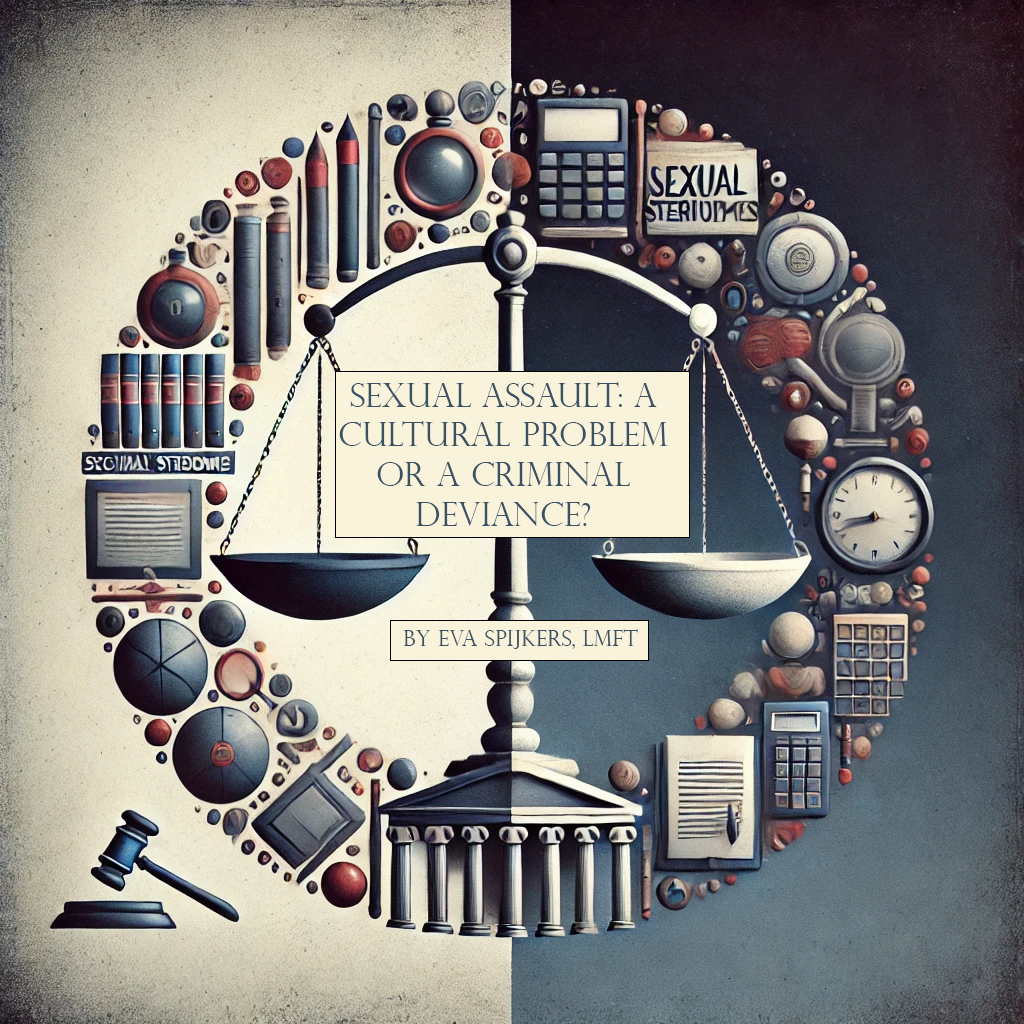Sexual Assault: A Cultural Problem or a Criminal Deviance?
By Eva Spijkers, LMFT
When we talk about sexual assault, we often treat it like a straightforward crime—something one person does to another, with clear lines between right and wrong. But is it really that simple? What if some forms of sexual assault aren’t just about individual behavior, but reflect deeper cultural problems? This question matters—not just for how we respond to sexual violence, but for how we prevent it.
Let’s start with the idea that sexual assault is a cultural problem, not just an individual crime. From this perspective, sexual violence isn’t always about a "bad person" doing something obviously violent. Instead, it can come from deeply ingrained beliefs about power, gender roles, and what sex is supposed to look like. Think about the guy at a party who keeps pressuring someone into going further than they want. He may not think of himself as doing harm. But if he doesn’t understand consent—real, enthusiastic, ongoing consent—he might cross a line without fully realizing it.
This doesn’t excuse the behavior, but it does help explain where it comes from. Research shows that many coercive or non-consensual behaviors aren’t rooted in sadism or deviance, but in misunderstanding, entitlement, or harmful social norms. As a culture, we’ve historically done a terrible job of teaching people what healthy, respectful sex actually looks like. In some cases, people don’t even realize that what they’re doing counts as assault—especially when it doesn’t involve physical force.
This is where things like consent education and changing cultural narratives come into play. We need to stop treating sexual assault as something that only “monsters” do. Because when we do that, we ignore the everyday, normalized behaviors—like pressuring someone into sex, or ignoring their hesitation—that can still cause deep harm.
You can see the cultural roots of this problem in online spaces like the manosphere—online communities where men trade toxic ideas about women, dating, and sex. From pickup artists to incel forums, these groups often teach men that they’re entitled to sex and that a woman’s “no” just means “try harder.” These ideologies don’t just warp people’s views of relationships—they actively promote behavior that violates consent.
And this doesn’t just hurt women. These spaces also erase or ignore the experiences of male and LGBTQ+ survivors, whose stories don’t always fit traditional narratives about sexual violence. Our cultural scripts about sex and gender leave little room for complexity—and that’s a huge part of the problem.
Still, framing sexual assault as a purely cultural or “sexual problem” has its limits. For one thing, it can make it seem like we just need better education to fix everything. And while education is crucial, that alone doesn’t do justice to the pain and trauma that survivors go through. Nor does it fully address people who knowingly and repeatedly violate others’ boundaries.
That’s where the idea of sexual deviance comes in—a term used in criminology to describe behaviors that clearly go against social norms and cause harm. When we’re talking about serial offenders or predatory behavior, this framing can be useful. These cases often are about individuals making conscious choices to harm others, and we need to take those seriously.
But not all cases are so black-and-white. Labeling everything as “deviant” can oversimplify the issue and make us miss the bigger picture. It can also lead us to focus only on the individual, without looking at the larger systems that shaped their behavior in the first place.
Here’s the truth: sexual assault is both a cultural problem and a matter of individual responsibility. The key is understanding the difference between someone who causes harm out of ignorance, entitlement, or social conditioning—and someone who does so with clear intent and disregard for others.
This doesn’t mean we excuse any of it. But it does mean we need different responses for different kinds of harm. Sometimes, the best intervention might be education or therapy. In other cases, it absolutely needs to involve legal consequences.
What we shouldn’t do is lump everything under one label. When we treat all sexual violence as the same, we lose our ability to respond thoughtfully. And when we ignore the cultural roots of the problem, we miss the opportunity to create real change.
So let’s stop asking whether sexual assault is a crime or a cultural issue—and start recognizing that it’s both. That’s the only way we can build a safer, more respectful world for everyone.

